Assay for ppm Levels of Azide in Drug Substances
LCGC Asia Pacific
The removal of azide as a potential impurity from a drug substance may be critical to its safety profile. The quantitation of this impurity is an important control parameter. This article describes a simple and practical assay for azide using chemical derivatization and HPLC. The method is shown to be suitable for the intended purpose on three example test materials. Potential issues for wider applications are discussed.
The removal of azide as a potential impurity from a drug substance may be critical to its safety profile, such that quantitation of this impurity becomes an important control parameter. This article describes a simple and practical assay for azide using chemical derivatization and high performance liquid chromatography. The method is shown to be suitable for the intended purpose on three example test materials. Potential issues for wider applications are discussed.
In the manufacturing of pharmaceutical drug substances in which azides are used as reagents or when they are generated somehow in the synthesis, it may be necessary to demonstrate that these impurities are sufficiently removed to levels below an appropriate safety threshold. The threshold would depend on the target dose and route of administration. Sodium azide is an example of an azide for which the environmental exposure limits have been reasonably well characterized (1). Testing for azides can be performed on the final drug substance, but may also be performed at critical control points in a synthesis such as with related compounds like starting materials and intermediates.

This article describes the use of pentafluorobenzyl bromide (PFBB) as a derivatization agent to form the pentafluorobenzyl-azide (PFB-Az) derivative, based on a known approach for synthesizing azides (2,3) as diagrammed in Figure 1.

Figure 1: PFBBâ azide derivatization reaction.
Relative to azide, the derivative can be easily detected by UV absorbance detection and is sufficiently nonpolar for retention on conventional reversed-phase high performance liquid chromatography (HPLC) analytical columns. Thus, there is potential to manage this reaction for application to parts-per-million analysis of azide as an impurity in drug substances and related compounds.
The literature describes the assay of azide in different modes, such as using ion-based HPLC (4–6), derivatization-based gas chromatography (GC) (7,8) and derivatization-based HPLC (9,10). The reagent PFBB has been used in conjunction with GC analysis (7,8), and other derivatization agents have been used in conjunction with HPLC analysis (9,10).
This article covers the assay of free azide, based on the use of sodium azide as the standard and spiking agent in method development. The work described herein is on three drug substance–related compounds exhibiting a range of polarity and complexity. Because of their proprietary nature, the three materials of interest will be designated as compounds A, B and C, where A is the most polar with the smallest molecular size, and C is the least polar with the largest molecular size.
Experimental
Materials: Sodium azide, pentafluorobenzylbromide (PFBB), dimethyl sulphoxide (DMSO), trifluoroacetic acid and acetonitrile were obtained from Sigma-Aldrich. Distilled deionized water was obtained through an in-house purification system.
Azide Standard and Test Sample Preparation: Azide standards were prepared using sodium azide in DMSO, in which target parts-per-million concentrations were set relative to free azide concentration. Test samples of compounds A, B and C were prepared at a 10-mg/mL target concentration in DMSO.
Derivatization Conditions: A PFBB stock solution was first prepared by transferring 100 μL of PFBB to a 5-mL volumetric flask, then the substance was diluted to flask volume with DMSO and the contents were mixed well. When 100 μL of this stock was added to a 5-mL volume of a standard or test sample solution, taking into account density and concentrations, the PFBB was present at 10-fold molar equivalents in excess over 1000 ppm free azide. A derivatized blank was prepared in a similar fashion in which 100 μL of the PFBB stock solution was added to 5 mL of DMSO. The derivatization had no quenching procedure, but it was shown that the reaction, whether for standards or test samples, required ~4–6 h to reach completion, and that the solutions exhibited no significant changes in HPLC profiles after at least 16 h in ambient conditions.
Chromatographic Analysis Conditions: The finalized HPLC conditions are summarized in Table 1.
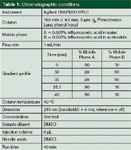
Table 1: Chromatographic conditions.
Results and Discussion
The objective was to develop testing conditions for trace-level azide within each test material of interest. The target sensitivity for azide in these materials was 500 ppm, though it was considered ideal to eventually achieve 50 ppm sensitivity if possible. A literature procedure (2,3) for reaction of azides with PFBB was adapted so that one could have a derivatization procedure for azide in the test materials of interest. The derivatized azide, PFB-Az, was expected to exhibit a chromophore suitable for UV detection and to be sufficiently nonpolar for retention on a reversed-phase HPLC column.
The first step was to demonstrate proof-of-feasibility for the derivatization reaction. Equimolar amounts of PFBB and sodium azide were combined in a DMSO vehicle, and the reaction was allowed to stir overnight under ambient conditions. This would ideally consume all PFBB and azide to form the PFB-Az derivative. The mixture was filtered to remove any salts, and then was analysed as a crude marker by proton nuclear magnetic resonance spectroscopy 1H-NMR), mass spectrometry (MS) and HPLC. The 1H-NMR analysis indicated that the reaction mixture contained no detectable PFBB and showed the presence of a new benzylic CH2 signal for the corresponding PFB-Az derivative at ~4.67 ppm in the NMR solvent (DMSO-d6). Given that the sodium azide contains no proton sources, it did not appear in the NMR spectra. Ion-trap MS analysis using flow injection in electrospray mode on an HPLC-linked system showed that the spectra of the reaction mixture resembled neither azide or PFBB, but there was no recognizable molecular ion observed consistent with the PFB-Az structure or the PFBB reagent. The components of interest may have been too volatile for proper detection under the conditions of the limited MS evaluation performed. The HPLC analysis demonstrated the absence of PFBB with concomitant formation of a new species. The two components were adequately resolved using the phenyl-hexyl stationary phase described in Table 1, and they exhibited uniquely different UV spectra. Some challenging column screening was necessary to reach this point, as the PFBB and PFB-Az components could not be separated using several well-known C18 stationary phases. The phenyl-hexyl phase provided acceptable separation of PFBB and PFB-Az from the test compound peaks as well.
The HPLC method development included optimization of the separation between PFBB and PFB-Az using DryLab software (LC Resources). Attention was also paid to column loading and how much excess PFBB could be tolerated for acceptable separation between PFBB and PFB-Az. Several detection wavelengths were evaluated, though 210 nm gave the best response factor for the PFB-Az derivative and hence the best potential for sensitivity. This lower wavelength resulted in DMSO appearing as a very broad peak at the void, but it was eluted well before any peaks of interest. The lower wavelength also tended to enhance responses from the test materials themselves. With this assay, peak shape and impurity separation for these three particular test materials were not issues, and therefore, there was no negative impact on PFB-Az quantitation. The finalized conditions shown in Table 1 reflect this development work.
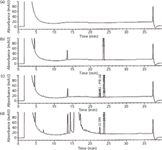
Figure 2: Panel overlay of example chromatograms: (a) DMSO blank, (b) derivatized blank, (c) derivatized 500 ppm azide standard, and (d) example derivatized spiked test sample (compound C).
The approximate retention times for relevant peaks are listed in Table 2. Chromatographic profiles are shown in Figure 2 for blanks, azide standards and an example test material.

Table 2: Retention time results.
The putative PFB-Az peak response was found to be directly proportional to the amount of azide present in standard solutions for a range 50–1000 ppm relative to a target 10 mg/mL test material concentration. The PFB-Az peak area vs. azide concentration plot exhibited a linear relationship with a 1.000 correlation coefficient (see Figure 3). Injection precision, separation from PFBB, spectral purity and peak shape were all acceptable. Signal-to-noise data, recovery values based on area-count proportionality and precision data supported a 50 ppm azide quantitation limit. The amount of PFBB reagent used was in excess of the free azide quantity by 10-fold in the 1000 ppm standard. The derivatization reaction was complete within 4–6 h, though mixtures were shown to be stable for at least 16 h. The standard-related results are summarized in Table 3.
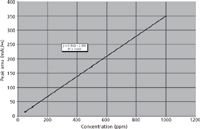
Figure 3: PFB-Az response vs. azide concentration.
A pivotal experiment was performed to demonstrate accuracy of the assay in the 50–1000 ppm range, with 500 ppm as the target level for each of the test materials. Samples of compound C, compound B and compound A were prepared as 10-mg/mL solutions in DMSO. Samples of these test materials were also spiked at 50, 500 and 1000 ppm free azide levels using sodium azide. All of these samples were derivatized with PFBB at 10-fold molar excess relative to the target free azide concentration present. Controls included test materials for which no PFBB was added. Standards at the 50, 500 and 1000 ppm free azide levels were also prepared and derivatized. Following the overnight ambient reaction, these samples, controls, standards and blanks were analysed by HPLC. For all of the spiked test materials, the PFB-Az peak was well separated from other components, and recoveries at each level were within 60–140%. The one exception involving compound C recovery at the 50 ppm level will be discussed below. Corresponding unspiked samples on the three test materials exhibited no detectable azide. The derivatization reaction was complete within 4–6 h, though mixtures were shown to be stable for at least 16 h. The sample-related results are summarized in Table 4.

Table 3: Performance results on azide standards.
The results discussed above demonstrate that the test conditions have a 50–1000 ppm range for azide quantitation in compounds A and B, whereas the range is slightly more limited at 200–1000 ppm for compound C.
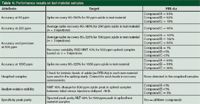
Table 4: Performance results on test material samples.
The results for compound C merited follow-up because azide recovery was poor with spiked samples at the 50 ppm level. Because this material lot was notably high in water content (near 8%), the hypothesis was that PFBB might be reacting with the water in competition with any azide present, in which case the problem would be exacerbated proportionally as a function of water content and inversely proportional to the azide level. The analysis of a second compound-C lot containing 1% water was evaluated in direct comparison with the original lot. The PFB-Az recovery values at 50 ppm azide spiking for the compound-C lots containing 8% water and 1% water were 21% and 45%, respectively. Given the variability in the assay, we believe that these differences in recovery values as a function of water content are significant. An attempt was made to overcome any water effects on derivatization by boosting the PFBB reagent concentration 10-fold, but the resulting chromatography was poor and impossible to interpret, reflecting what appeared to be unwanted alternate reactions in the samples.
Conclusions
The chromatographic conditions developed for a parts-per-million-level assay of azide in several specific drug substance-related compounds were shown to be suitable for the intended purpose. While the three test materials used in this development project happened to all be eluted sufficiently before the PBF-Az peak, it is recognized that other users of this assay for different projects could very well have to perform targeted chromatographic method development as necessary. This paper also discussed the potential issues with certain materials such as compound C. Assay of this substance may be affected by abundant water competing for the PFBB reagent, though reactivity with functional groups on the test material has not been ruled out. For this material, one could further probe the effect of water on derivatization through drying and water-spiking studies. Thus, the analyst should be on the lookout for conversion problems because of water content and functional groups present on the test compound. Given that alcohols can also compete with the derivatization reaction, this discussion may be extended to them as well, whether as solvates or impurities.
The objective of this study was to have an assay with at least 500-ppm azide sensitivity in three specific drug substance-related compounds that exhibit a fairly wide polarity range. Certainly, depending on the test material being analysed, there is potential to achieve greater sensitivity through enhanced loading and refinement of derivatization conditions. At the very least, the work described in this article can provide a nice starting point for anyone interested in azide derivatization and quantitative analysis by HPLC.
P.W. Wrezel, M.R. Lutz Jr., I. Likhotvorik and J. Cao are with Regis Technologies, Inc., in Morton Grove, Illinois, USA.
References
(1) Environmental Protection Agency Web Site, www.epa.gov/ncea/iris.
(2) C. Pardin, I. Roy, W.D. Lubell and J.W. Keillor, Chem. Biol. Drug Des. 72, 189–196 (2008).
(3) S.G. Alvarez and M.T. Alvarez, Synthesis 4, 413–414 (1997).
(4) N.H. Subramanian, V.R.S. Babu, R.G. Jeevan and G. Radhakrishnan, J. Chrom. Sci. 47, 529–533 (2009).
(5) E. Marengo, M.C. Gennaro, C. Abrigo and A. Dinardo, Anal. Chem. 66, 4229–4235 (1994).
(6) K. Vinkovic and V. Drevenkar, J. Chrom. B 864, 102–108 (2008).
(7) M. Kikuchi, M. Sato, T. Ito and M. Honda, J. Chrom. B 752, 149–157 (2001).
(8) A. Miki, M. Nishikawa and H. Tsuchihashi, J. Health Sci. 46, 81–88 (2000).
(9) S.J. Swarin and R.A. Waldo, J. Liquid Chrom. 5, 597–604 (1982).
(10) P. Marquet, S. Clement, H. Lotfi, M.F. Dreyfuss, J. Debord, D. Dumont and G. Lachatre, J. Anal. Toxicol. 20, 134–138 (1996).
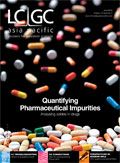
New TRC Facility Accelerates Innovation and Delivery
April 25th 2025We’ve expanded our capabilities with a state-of-the-art, 200,000 sq ft TRC facility in Toronto, completed in 2024 and staffed by over 100 PhD- and MSc-level scientists. This investment enables the development of more innovative compounds, a broader catalogue and custom offering, and streamlined operations for faster delivery. • Our extensive range of over 100,000 high-quality research chemicals—including APIs, metabolites, and impurities in both native and stable isotope-labelled forms—provides essential tools for uncovering molecular disease mechanisms and exploring new opportunities for therapeutic intervention.
New Guide: Characterising Impurity Standards – What Defines “Good Enough?”
April 25th 2025Impurity reference standards (IRSs) are essential for accurately identifying and quantifying impurities in pharmaceutical development and manufacturing. Yet, with limited regulatory guidance on how much characterisation is truly required for different applications, selecting the right standard can be challenging. To help, LGC has developed a new interactive multimedia guide, packed with expert insights to support your decision-making and give you greater confidence when choosing the right IRS for your specific needs.

.png&w=3840&q=75)

.png&w=3840&q=75)



.png&w=3840&q=75)



.png&w=3840&q=75)










